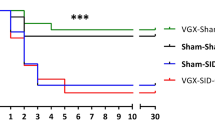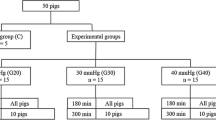Abstract
Background
Secretory immunoglobulin A (s-IgA) plays an important role in both gut and systemic immunity. This study aimed to investigate the production of s-IgA resulting from a CO2 pneumoperitoneum compared with a laparotomy.
Methods
Using enzyme-linked immunosorbent assays, s-IgA in stool, malondialdehyde (MDA), and Toll-like receptor 4 (TLR4) in the ileal tissue were evaluated as markers for gut and systemic immune responses in an animal model. The rats were randomly divided into (i) anesthesia-only as the control group; (ii) laparotomy-only as the open group; and (iii) CO2 pneumoperitoneum-only as the pneumoperitoneum group. To evaluate the gut immune system in a time-dependent manner, each group was further divided into short- and long-time subgroups.
Results
s-IgA levels did not increase in the open group but significantly increased in the pneumoperitoneum group compared with the control group (p < 0.05). In addition, s-IgA levels in the long-time subgroup significantly increased compared with the short-time subgroup of the pneumoperitoneum group (p < 0.05). TLR4 levels steeply and gradually increased in the open and pneumoperitoneum groups, respectively. MDA levels in the pneumoperitoneum group increased during the early phase and were significantly higher than those in the open group at 24 h (p < 0.05).
Conclusions
This study demonstrated that s-IgA levels in stool increased in the pneumoperitoneum group compared with the open group, suggesting that CO2 pneumoperitoneum may cause transitory damage to the intestinal mucosa.




Similar content being viewed by others
References
Leduc LJ, Mitchell A (2006) Intestinal ischemia after laparoscopic cholecystectomy. JSLS 10:236–238
Bandyopadhyay D, Kapadia CR (2003) Large bowel ischemia following laparoscopic inguinal hernioplasty. Surg Endosc 17:520–521
Etoh T, Shiraishi N, Tajima M, Shiromizu A, Yasuda K, Inomata M et al (2007) Transient liver dysfunction after laparoscopic gastrectomy for gastric cancer patients. World J Surg 31:1115–1120
Windberger UB, Auer R, Keplinger F, Längle F, Heinze G, Schindl M et al (1999) The role of intra-abdominal pressure on splanchnic and pulmonary hemodynamic and metabolic changes during carbon dioxide pneumoperitoneum. Gastrointest Endosc 49:84–91
Glantzounis GK, Tselepis AD, Tambaki AP, Trikalinos TA, Manataki AD, Galaris DA et al (2001) Laparoscopic surgery-induced changes in oxidative stress markers in human plasma. Surg Endosc 15:1315–1319
Windsor MA, Bonham MJ, Rumball M (1997) Splanchnic mucosal ischemia: an unrecognized consequence of routine pneumoperitoneum. Surg Laparosc Endosc 7:480–482
Nickkholgh A, Barro-Bejarano M, Liang R, Zorn M, Mehrabi A, Gebhard MM et al (2008) Signs of reperfusion injury following CO2 pneumoperitoneum: an in vivo microscopy study. Surg Endosc 22:122–128
Kaya Y, Coskun T, Demir MA, Var A, Ozsoy Y, Aydemir EO (2002) Abdominal insufflation-deflation injury in small intestine in rabbits. Eur J Surg 168:410–417
Eleftheriadis E, Kotzampassi K, Papanotas K, Heliadis N, Sarris K (1996) Gut ischemia, oxidative stress, and bacterial translocation in elevated abdominal pressure in rats. World J Surg 20:11–16
Tsuboi S, Kitano S, Yoshida T, Bandoh T, Ninomiya K, Baatar D (2002) Effects of carbon dioxide pneumoperitoneum on hemodynamics in cirrhotic rats. Surg Endosc 16:1220–1225
Ke B, Shen XD, Kamo N, Ji H, Yue S, Gao F et al (2013) β-catenin regulates innate and adaptive immunity in mouse liver ischemia-reperfusion injury. Hepatology 57:1203–1214
Eltzschig HK, Eckle T (2011) Ischemia and reperfusion: from mechanism to translation. Nat Med 17:1391–1401
Hase K, Kawano K, Nochi T, Pontes GS, Fukuda S, Ebisawa M et al (2009) Uptake through glycoprotein 2 of FimH(+) bacteria by M cells initiates mucosal immune response. Nature 462:226–230
Medzhitov R, Preston-Hurlburt P, Janeway CA (1997) A human homologue of the Drosophila Toll protein signals activation of adaptive immunity. Nature 388:394–397
Shang L, Fukata M, Thirunarayanan N, Martin AP, Arnaboldi P, Maussang D et al (2008) Toll-like receptor signaling in small intestinal epithelium promotes B-cell recruitment and IgA production in lamina propria. Gastroenterology 135:529–538
Del Rio D, Stewart AJ, Pellegrini N (2005) A review of recent studies on malondialdehyde as toxic molecule and biological marker of oxidative stress. Nutr Metab Cardiovasc Dis 15:316–328
Russell MW, Sibley DA, Nikolova EB, Tomana M, Mestecky J (1997) IgA antibody as a non-inflammatory regulator of immunity. Biochem Soc Trans 25:466–470
Flohé L, Brigelius-Flohé R, Saliou C, Traber MG, Packer L (1997) Redox regulation of NF-kappa B activation. Free Radic Biol Med 22:1115–1126
Janssen-Heininger YM, Poynter ME, Baeuerle PA (2000) Recent advances towards understanding redox mechanisms in the activation of nuclear factor kappaB. Free Radic Biol Med 28:1317–1327
Kato T, Owen RL (2005) Structure and function of intestinal mucosal eptihelium. In: Mestecky J, Lamm ME, McGhee JR, Bienenstock J, Mayer L, Strober W (eds) Mucosal immunology. Elsevier Inc., San Diego, pp 131–151
Neutra MR, Kraehenbuhl J-P (2005) Cellular and molecular basis for antigen transport across epithelial barriers. In: Mestecky J, Lamm ME, McGhee JR, Bienenstock J, Mayer L, Strober W (eds) Mucosal immunology. Elsevier Inc., San Diego, pp 111–130
Vijay-Kumar M, Gewirtz AT (2005) Role of epithelium in mucosal immunity. In: Mestecky J, Lamm ME, McGhee JR, Bienenstock J, Mayer L, Strober W (eds) Mucosal immunology. Elsevier Inc., San Diego, pp 423–434
Unsal MA, Guven S, Imamoglu M, Aydin S, Alver A (2009) The effect of CO2 insufflation-desufflation attacks on tissue oxidative stress markers during laparoscopy: a rat model. Fertil Steril 92:363–368
Dai S, Sodhi C, Cetin S, Richardson W, Branca M, Neal MD et al (2010) Extracellular high mobility group box-1 (HMGB1) inhibits enterocyte migration via activation of Toll-like receptor-4 and increased cell-matrix adhesiveness. J Biol Chem 285:4995–5002
Yao L, Kan EM, Lu J, Hao A, Dheen ST, Kaur C et al (2013) Toll-like receptor 4 mediates microglial activation and production of inflammatory mediators in neonatal rat brain following hypoxia: role of TLR4 in hypoxic microglia. J Neuroinflammation 10:23
Zhang Y, Peng T, Zhu H, Zheng X, Zhang X, Jiang N et al (2010) Prevention of hyperglycemia-induced myocardial apoptosis by gene silencing of Toll-like receptor-4. J Transl Med 8:133
Akira S, Sato S (2003) Toll-like receptors and their signaling mechanisms. Scand J Infect Dis 35:555–562
Kimoto M, Nagasawa K, Miyake K (2003) Role of TLR4/MD-2 and RP105/MD-1 in innate recognition of lipopolysaccharide. Scand J Infect Dis 35:568–572
Miyake K (2004) Innate recognition of lipopolysaccharide by Toll-like receptor 4-MD-2. Trends Microbiol 12:186–192
Kontoulis TM, Pissas DG, Pavlidis TE, Pissas GG, Lalountas MA, Koliakos G et al (2012) The oxidative effect of prolonged CO(2) pneumoperitoneum a comparative study in rats. J Surg Res 175:259–264
Sammour T, Mittal A, Loveday BP, Kahokehr A, Phillips AR, Windsor JA et al (2009) Systematic review of oxidative stress associated with pneumoperitoneum. Br J Surg 96:836–850
Jakimowicz J, Stultiëns G, Smulders F (1998) Laparoscopic insufflation of the abdomen reduces portal venous flow. Surg Endosc 12:129–132
Takagi S (1998) Hepatic and portal vein blood flow during carbon dioxide pneumoperitoneum for laparoscopic hepatectomy. Surg Endosc 12:427–431
Evasovich MR, Clark TC, Horattas MC, Holda S, Treen L (1996) Does pneumoperitoneum during laparoscopy increase bacterial translocation? Surg Endosc 10:1176–1179
Hiki N, Shimizu N, Yamaguchi H, Imamura K, Kami K, Kubota K et al (2006) Manipulation of the small intestine as a cause of the increased inflammatory response after open compared with laparoscopic surgery. Br J Surg 93:195–204
Galdeano CM, Perdigón G (2006) The probiotic bacterium Lactobacillus casei induces activation of the gut mucosal immune system through innate immunity. Clin Vaccine Immunol 13:219–226
Kawamoto S, Tran TH, Maruya M, Suzuki K, Tsutsui Y et al (2012) The inhibitory receptor PD-1 regulates IgA selection and bacterial composition in the gut. Science 336:485–489
Disclosures
Drs. Toru Kusano, Tsuyoshi Etoh, Masafumi Inomata, Norio Shiraishi, and Seigo Kitano have no conflicts of interest or financial ties to disclose.
Author information
Authors and Affiliations
Corresponding author
Rights and permissions
About this article
Cite this article
Kusano, T., Etoh, T., Inomata, M. et al. CO2 pneumoperitoneum increases secretory IgA levels in the gut compared with laparotomy in an experimental animal model. Surg Endosc 28, 1879–1885 (2014). https://doi.org/10.1007/s00464-013-3408-3
Received:
Accepted:
Published:
Issue Date:
DOI: https://doi.org/10.1007/s00464-013-3408-3




